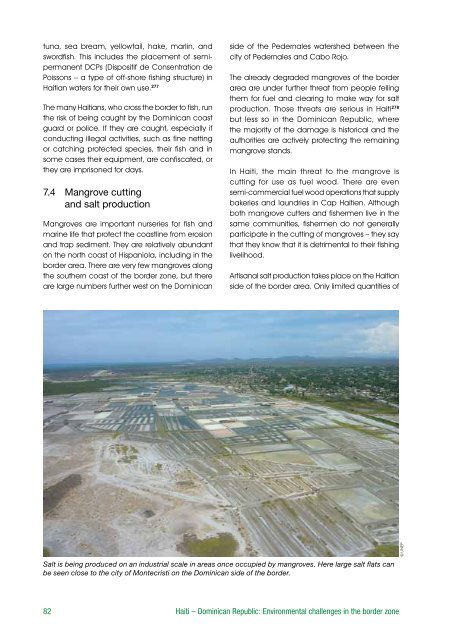Haiti – Dominican Republic - Disasters and Conflicts - UNEP
Haiti – Dominican Republic - Disasters and Conflicts - UNEP
Haiti – Dominican Republic - Disasters and Conflicts - UNEP
- No tags were found...
You also want an ePaper? Increase the reach of your titles
YUMPU automatically turns print PDFs into web optimized ePapers that Google loves.
tuna, sea bream, yellowtail, hake, marlin, <strong>and</strong>swordfish. This includes the placement of semipermanentDCPs (Dispositif de Consentration dePoissons <strong>–</strong> a type of off-shore fishing structure) in<strong>Haiti</strong>an waters for their own use. 277The many <strong>Haiti</strong>ans, who cross the border to fish, runthe risk of being caught by the <strong>Dominican</strong> coastguard or police. If they are caught, especially ifconducting illegal activities, such as fine nettingor catching protected species, their fish <strong>and</strong> insome cases their equipment, are confiscated, orthey are imprisoned for days.7.4 Mangrove cutting<strong>and</strong> salt productionMangroves are important nurseries for fish <strong>and</strong>marine life that protect the coastline from erosion<strong>and</strong> trap sediment. They are relatively abundanton the north coast of Hispaniola, including in theborder area. There are very few mangroves alongthe southern coast of the border zone, but thereare large numbers further west on the <strong>Dominican</strong>side of the Pedernales watershed between thecity of Pedernales <strong>and</strong> Cabo Rojo.The already degraded mangroves of the borderarea are under further threat from people fellingthem for fuel <strong>and</strong> clearing to make way for saltproduction. Those threats are serious in <strong>Haiti</strong> 278but less so in the <strong>Dominican</strong> <strong>Republic</strong>, wherethe majority of the damage is historical <strong>and</strong> theauthorities are actively protecting the remainingmangrove st<strong>and</strong>s.In <strong>Haiti</strong>, the main threat to the mangrove iscutting for use as fuel wood. There are evensemi-commercial fuel wood operations that supplybakeries <strong>and</strong> laundries in Cap Haïtien. Althoughboth mangrove cutters <strong>and</strong> fishermen live in thesame communities, fishermen do not generallyparticipate in the cutting of mangroves <strong>–</strong> they saythat they know that it is detrimental to their fishinglivelihood.Artisanal salt production takes place on the <strong>Haiti</strong>anside of the border area. Only limited quantities ofSalt is being produced on an industrial scale in areas once occupied by mangroves. Here large salt flats canbe seen close to the city of Montecristi on the <strong>Dominican</strong> side of the border.© <strong>UNEP</strong>82 <strong>Haiti</strong> <strong>–</strong> <strong>Dominican</strong> <strong>Republic</strong>: Environmental challenges in the border zone
















